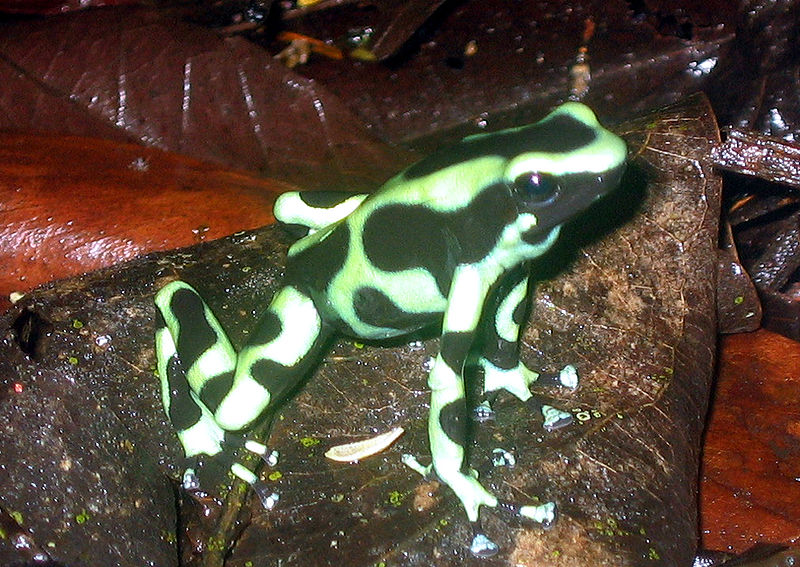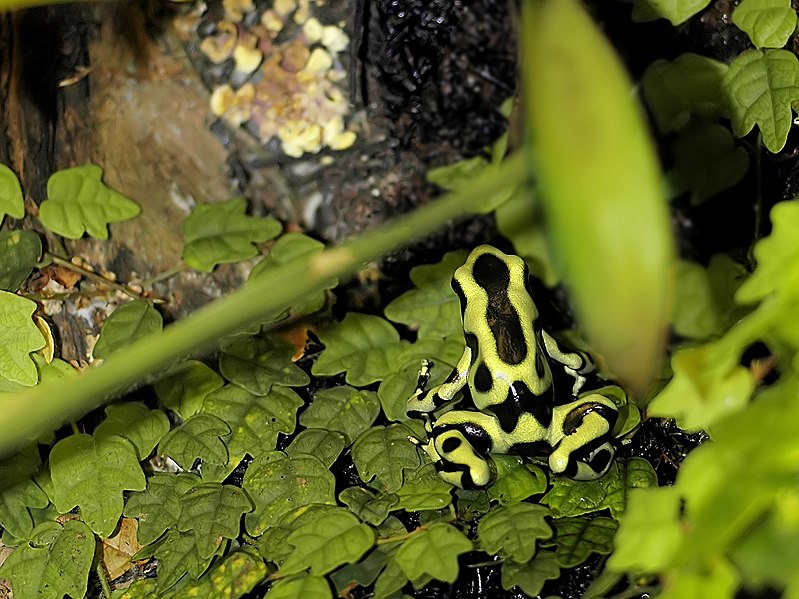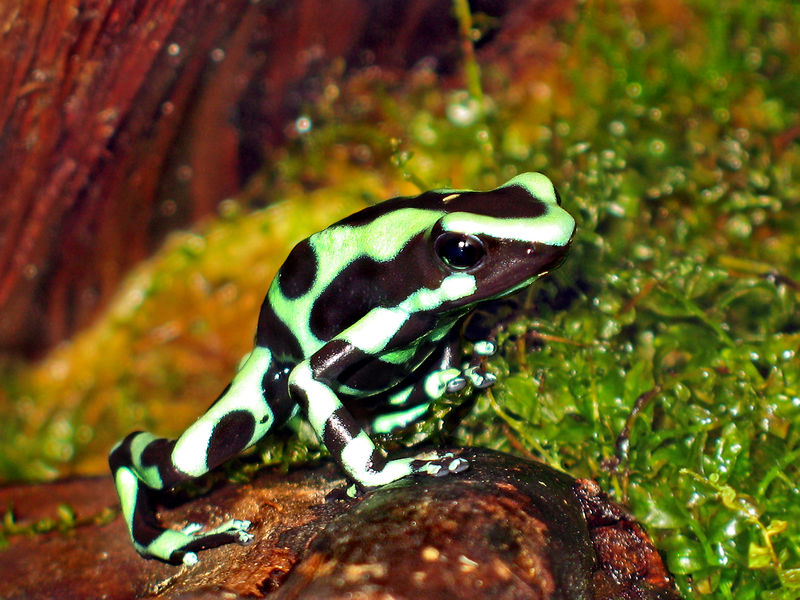 I’ve always favored the boldly-marked Green and Black Poison (or “Dart”) Frog, Dendrobates auratus, over most of its relatives. This was a turn of good fortune for me, as this gorgeous creature is one of the largest and easiest of the poison frogs to maintain. It is also not at all shy – while working in Costa Rica, I was surprised at how easy wild ones were to observe – and makes a wonderful exhibit animal. Green and Black Poison Frogs have become almost common in the trade, yet many remain unaware of some surprising aspects of their lives in the wild.
I’ve always favored the boldly-marked Green and Black Poison (or “Dart”) Frog, Dendrobates auratus, over most of its relatives. This was a turn of good fortune for me, as this gorgeous creature is one of the largest and easiest of the poison frogs to maintain. It is also not at all shy – while working in Costa Rica, I was surprised at how easy wild ones were to observe – and makes a wonderful exhibit animal. Green and Black Poison Frogs have become almost common in the trade, yet many remain unaware of some surprising aspects of their lives in the wild.
Little-Known Facts
First a few notes that have surprised me over the years.
Hobbyists accustomed to seeing these frogs in terrariums may be surprised to learn that wild specimens sometimes venture into forest canopies over 100 feet above ground…quite a climb for a minute frog!
Females wrestle one another for mating rights, and actively court males, who may ignore them until “tapped” on the back. They may also consume the eggs of rival females.
Male Green and Black Poison Frogs may mate with up to 6 females, and care for the broods of each simultaneously. Despite this, males seem able to “predict” hatching times, and seem always on hand to transport the tadpoles to water.
In those wild populations studied, ants were found to form the bulk of the diet.
At least 25 distinct color morphs have been identified. Some individuals vary so much from the “norm” that they appear to be of an entirely different species.
Description
 One of the larger members of the family Dendrobatidae, Green and Black Poison Frogs range from 1 to 1.7 inches in length, and are stoutly built.
One of the larger members of the family Dendrobatidae, Green and Black Poison Frogs range from 1 to 1.7 inches in length, and are stoutly built.
In typical specimens, the dorsal surface is brilliant green on a black background, and the stomach is mottled with yellow, blue or orange. There are, however, at least 25 different color phases, with background colors ranging from nearly white to blue-green. Pattern varies greatly as well, and may be in the form of wide or thick stripes, dots, circles or a combination thereof.
Range
This frog ranges from southeastern Nicaragua and southeastern Costa Rica to extreme northwestern Columbia. They were introduced to Oahu, Hawaii, in 1932, and thrive there today.
Habitat
Humid lowland rainforests are favored, and many populations are limited to the forest interior. However, I have observed them in rather open habitats in Costa Rica, and researchers report that the species adapts well to some habitat modification.
Status
This frog is sometimes common within its range, but there is concern as the range itself is quite small. They breed well in zoos and private collections.
Reproduction
The reproductive behavior is among the most complicated in the amphibian world.
Male frogs establish territories of up to 5 meters square in areas of high population density, but are more tolerant where populations are smaller. They call with an insect-like buzz, and may mate with up to 6 females (males care for multiple clutches of eggs simultaneously). Females wrestle with others and chase them from the male’s territory, and will consume their rivals’ eggs. Females are ignored upon first responding to the male’s call, and court him by standing on his back and tapping and pushing with their feet and legs.
 The female is eventually led to a nest site below the leaf litter, where she lays 4-6 eggs, which are externally fertilized. The male moves from clutch to clutch, shedding water on the eggs, rotating them and removing fungus. Males seem able to predict hatching, and are nearly always present at that time (hatching occurs in 10-14 days). The male carries the tadpoles, usually 1 at a time, on his back and transports them to temporary pools of water in tree holes or bromeliad bases.
The female is eventually led to a nest site below the leaf litter, where she lays 4-6 eggs, which are externally fertilized. The male moves from clutch to clutch, shedding water on the eggs, rotating them and removing fungus. Males seem able to predict hatching, and are nearly always present at that time (hatching occurs in 10-14 days). The male carries the tadpoles, usually 1 at a time, on his back and transports them to temporary pools of water in tree holes or bromeliad bases.
The tadpoles feed upon algae, detritus, small invertebrates and each other, and transform in 9-15 weeks.
Diet
Ants form the bulk of the diet, but termites, springtails, millipedes, beetle, flies and other tiny invertebrates are also taken.
Skin Toxins
This frog, and others within the family Dendrobatidae, secretes virulent skin toxins (histrionicotoxins, batrachotoxins and others) when disturbed. The toxins are derived from ants, millipedes and, perhaps, other invertebrates.
A compound isolated from the secretions of the Phantasmal Poison Frog, Epipedobates tricolor, shows great promise as a pain medication. It is more effective than morphine, non-addictive, and non-sedating.
The use of frog toxins on hunting darts was first reported in the literature in 1823, by British naval captain C. Cochrane. A jaguar shot with a toxin-treated dart was said to die within 4-5 minutes.
 Please see the article below for further information.
Please see the article below for further information.
Captive Care
Green and Black Poison Frogs do very well if provided for properly, and often reward owners by breeding regularly. Their care and breeding follows that of the Blue Poison Frog; please see the article below for details.
Further Reading
Photos and locality information for 25 color morphs
Use of Frog Toxins in Hunting and Warfare
Green and Black PA Frog (2nd) image referenced from wikipedia and originally posted by Hans Hillewaert
Bromeliad cup center image referenced from wikipedia and originally posted by Bocabroms
Green and Black PA Frog (3rd) image referenced from wikipedia and originally posted by Wildfeurer
 That Reptile Blog – Reptile, Amphibian and Exotic Pet Care and Information
That Reptile Blog – Reptile, Amphibian and Exotic Pet Care and Information



i just got an Auratus the other day, this was a very educational and interesting article. great job Frank!
Hello Grahm,
Thanks for your interest and the kind words.
Please let me know if you need any further information on caring for your frog. Good luck, enjoy and please keep me posted.
Best regards, Frank Indiviglio.